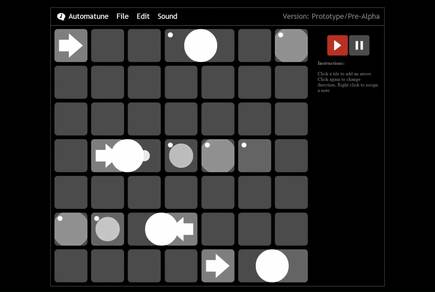Automatune
Procedural music editor
https://automatune.maxlaumeister.com/
Easy procedural music
Automatune is an easy-to-use procedural music editor that doesn’t require any coding or special knowledge. The name Automatune comes from the word “automaton”. Automatune is an automaton that makes tunes!
When you add arrows and notes to the Automatune grid, the dots will follow the arrows, playing any notes they encounter along the way. Automatune has customizations for grid size and tempo, and even lets you share your creations by URL or by saving them to a file.
Please note: because Automatune was written for a different web era back when I was a much younger and inexperienced developer, I recommend running it in Google Chrome for the smoothest experience. To play around with the newest version of the app, launch Automatune.
In 2018 a Unity3D version of Automatune was created by Gabriele Picco, and is available for Android and iOS. (Video). This version of Automatune is untested and unaffiliated.
Tech Stack
Automatune is written in HTML, CSS, and vanilla Javascript, and it makes limited use of jQuery for its menu system. The project is written in a way that makes it easily extensible, and it is thoroughly documented using jsDoc.
Automatune is open source and licensed under GPL.
Related Works
Automatune was inspired by Tone Matrix (HTML5 version), and incorporates a similar approach to 2D visual programming as the game SpaceChem.
Here is a list of some additional related projects:
- ToneCraft and Plink, web music experiments by Dinahmoe.
- WolframTones, an exploration of music generated by cellular automata.
- Music from Very Short Programs, a showcase of music created by interpreting output from very small programs as sound.
- Abundant-Music, an algorithmic music generator by Per Nyblom.
- Sim Cell sound design by Leonard J. Paul.
- Electroplankton, an interactive music game for the Nintendo DS handheld gaming system.


